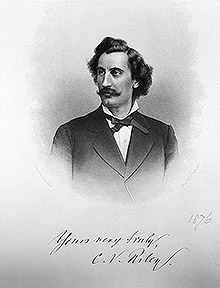Charles Valentine Riley facts for kids
Quick facts for kids
Charles Valentine Riley
|
|
|---|---|
 |
|
| Born | 18 September 1843 |
| Died | September 14, 1895 (aged 51) |
| Citizenship | Naturalized American citizen |
| Scientific career | |
| Fields | Entomology |
Charles Valentine Riley (born September 18, 1843 – died September 14, 1895) was a smart scientist and artist. He was born in Britain but became an American citizen. He studied entomology, which is the study of insects.
Riley was one of the first people to use a special way to control pests. This method is called biological pest control. He wrote more than 2,400 articles and books about insects! He also helped create important groups like the United States Entomological Commission.
Contents
Early Life and Moving to America
Charles Valentine Riley was born in London, England, on September 18, 1843. His father was a minister. When Charles was about eleven, his parents sent him to schools in Europe. He was very good at art and studying natural history. He went to private schools in Dieppe, France and Bonn, Germany.
After his father passed away, Charles came back to Britain. When he was seventeen, he decided to move to America. He didn't have much money or resources.
Riley ended up in Illinois, where he worked on a farm. Later, he started working for a farm magazine called Prairie Farmer. He was a reporter, artist, and editor for the insect section.
Amazing Career in Entomology
In 1868, Riley became the first State Entomologist for Missouri. He wrote many reports about insects in Missouri. This work made him one of the top insect scientists in the United States.
Fighting Grasshoppers
Between 1873 and 1877, many Western states faced a huge problem. There was a terrible plague of grasshoppers. Riley studied this problem and found ways to help. He convinced the United States Congress to create the United States Entomological Commission. This group included a special Grasshopper Commission, and Riley became its leader.
Working for the Government
In 1878, Riley became the main insect scientist for the U.S. Department of Agriculture. He left for a short time but came back in 1881. He stayed in this important job until 1894. He also became the first person to manage the insect collection at the Smithsonian Institution in 1885. Riley later gave his own huge collection of 100,000 insect specimens to the Smithsonian.
Father of Biological Control
Riley was one of the first scientists to use biological pest control. This means using natural enemies to fight pests. For example, he brought in a special beetle to fight an insect that was hurting California's citrus fruit trees. Because this method worked so well, some people call Riley the "Father of Biological Control." He also invented a special nozzle for spraying plants.
Saving French Grapes
Riley noticed that American grapevines were strong against a tiny insect called Phylloxera. This pest was destroying grapevines in France. Riley worked with another scientist, J. E. Planchon. They found a way to save the French wine industry. They used American grapevine roots and grafted French grapevines onto them.
For his amazing work, Riley received a special medal from France. He was also named a Chevalier of the Legion of Honor in 1884.
Writing and Leadership
Charles Riley was a very busy person. He wrote over 2,400 publications! He also published two journals about insects: The American Entomologist and Insect Life. He helped start the American Association of Economic Entomologists. This group later became part of the Entomological Society of America.
Riley received special degrees from Kansas State University and the University of Missouri. He was also an honorary member of the Royal Entomological Society in London.
Family Life
In 1878, Charles Riley married Emilie Conzelman in St. Louis, Missouri. Emilie's father was from Germany, and her mother was from Denmark. Charles and Emilie had seven children together. They had five girls and two boys.
Sad End
On September 14, 1895, Charles Riley died in a bicycle accident. He was riding his bike down a hill in Washington, D.C. His bicycle hit a stone block, and he fell, hurting his head. He was taken home but never woke up. He passed away at age 52, leaving behind his wife and six children.
Images for kids
See also
 In Spanish: Charles Valentine Riley para niños
In Spanish: Charles Valentine Riley para niños


